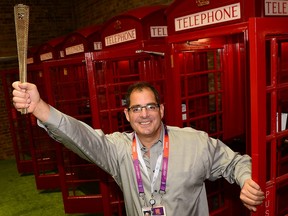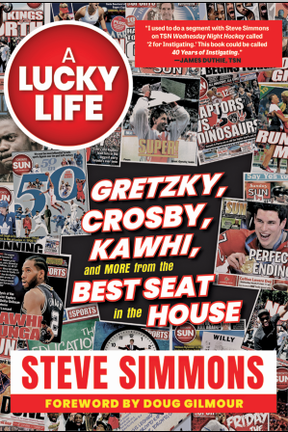
PAUL WOODS
Special to Postmedia
A group of old friends were chewing the fat one day when the discussion turned to a game of ‘Where were you when …?’
As the Canadian national soccer teams head to their respective FIFA World Cups, Derek Van Diest is on the scene to cover all the action. Expect expert insights and analysis in your inbox daily throughout the tournaments, and weekly on Thursdays for the rest of the season.
Thanks for signing up!
A welcome email is on its way. If you don't see it, please check your junk folder.
The next issue of Corner Kicks with Derek Van Diest will soon be in your inbox.
The big events of their lifetimes: The first moon landing, the JFK assassination, the planes slamming into the twin towers.
The discussion then turned to milestone sporting events. Where were you when Sidney Crosby scored the golden goal? When Donovan Bailey won the Olympic 100 metres? When Usain Bolt destroyed the competition with a race for the ages?
One guy kept answering: “I was there.”
That guy was Steve Simmons. He came away from the discussion pondering how many incredible sporting events he has been fortunate to cover in four decades as a sports journalist, including the past 35 years writing columns for the Toronto Sun and other Postmedia newspapers.
“It just hit me at that point — you’ve got something,” Simmons recalls. That was the impetus for A Lucky Life: Gretzky, Crosby, Kawhi, and More from the Best Seat in the House. Published on Nov. 7 by Triumph Books, A Lucky Life aggregates 89 of the more than 8,000 sports columns he has written over the years.
Most of the columns are about 800 words long, readable in four to five minutes.
Simmons envisages it becoming a book people pick up in the bathroom: Open to any page and you will find a self-contained story you can enjoy in about the time it takes to complete your business.
A Lucky Life is broken into sections covering legends and champions, important figures in the major sports, and remembrances of individuals whose deaths presented an opportunity to reflect on their legacy.
Figuring out how to condense a life’s work into a collection representing barely 1% of everything he has ever written was challenging, to say the least.
Simmons dug into the Sun/Postmedia archives, which dates back to 1990, to pick and choose. He also found a few pre-1990 columns in a byline clipping file he “borrowed” from the Calgary Herald’s library when he left that paper in 1987.
Simmons knew he had to include the most important individuals he has covered. The collection naturally includes pieces on Wayne Gretzky, Bolt, Gordie Howe, Muhammad Ali, Tom Brady and Tiger Woods, among many other sporting heroes.
The biggest events are there, too. Crosby’s gold-medal-winning goal at the Vancouver Olympics, Kawhi Leonard’s bouncing buzzer-beater, Joe Carter’s ‘touch ’em all’ homer, Bailey’s magical race in Atlanta.
But Simmons also wanted to include great stories, even if the protagonists weren’t particularly well known. So there are columns about Jermaine Gabriel’s journey from homelessness to Grey Cup champion, the basketball encyclopedia named Wayne Embry, the remarkable but little-known Olympian Kathleen Heddle, and life lessons Simmons learned as a coach of young hockey players.
“I wanted it to be historical, and to (include) stories that people wouldn’t know or remember. I wanted to have Brady and Gretzky and the Kawhi shot, (Roberto) Alomar’s home run, Carter’s home run — things that matter, especially to Toronto — plus showing different sides of things I’ve done.
“The book shows I’m a storyteller. I can tell stories pretty darn well.”

♦ ♦ ♦
Telling sports stories is a habit Simmons acquired early in life. His dad, Jerry, was a sports nut and at one point had season’s tickets for the Toronto Argonauts, Hamilton Tiger-Cats and Buffalo Bills.
Steve and his father would spend a day each summer observing the Argos at training camp. Each would then write down his projected lineup and place it in a sealed envelope. They would open the envelope on cutdown day to see whose predictions were closest to the final roster.
Simmons served as sports editor for the yearbook at York Mills Collegiate. One day Dick Beddoes, longtime sports columnist for The Globe and Mail, came to the school to talk about his career. Most students wanted to talk about the Leafs rather than journalism.
Finally Beddoes exploded: “I’m here to talk to anyone interested in pursuing this as a career. If you’re not, leave.”
The room cleared except for one student: Simmons. “I had 10 minutes with Beddoes to myself.”
At Western University, Simmons saw an ad soliciting writers for the student paper, The Gazette.
Soon he was spending far more time at the paper than in class. He became sports editor, then got elected to the full-time job of managing editor in 1979. But before he could start that $190-a-week job, he accepted an offer to become a junior hockey reporter for the Calgary Herald.
(Disclosure: After running for editor-in-chief on a ticket with Steve — he won, I lost — I happily stepped into the managing editor job he had vacated.)
The 14th sports reporter on a staff of 14, Simmons was not expected to make an immediate impact at the Herald. But one of his contacts tipped him off that Cliff Fletcher, general manager of the Atlanta Flames, was shopping for three houses in the Alberta city, for himself and two lieutenants.
Rumours that the Flames might move to Calgary had been swirling for weeks. Simmons was the first journalist to uncover hard evidence. His story made the front page of the Herald.
Soon after, Simmons was offered a high-profile job at the upstart Calgary Sun: Beat reporter covering the Stampeders and the CFL. He later worked the Flames beat before becoming sports editor.
A chance encounter with the Herald’s publisher resulted in an offer to move back to the more established paper. At 25, Simmons became Canada’s youngest sports columnist.
In 1987, the Toronto Sun’s new sports editor, Wayne Parrish, wooed Simmons back to his hometown. Initially, he was responsible for “take-outs and projects, kind of an all-purpose guy.” But before long, he became a full-time columnist.
At Parrish’s urging, Simmons created a notebook column for the Sunday paper. Every week, he assembles a 2,400-word grab-bag of (mostly) unrelated thoughts, observations and opinions about the world of sports. The two-page spread is Canada’s most widely read sports column.
“It’s what I’m known for, and it’s the biggest pain in the ass in my life because it’s really hard to do,” Simmons says. “I always try to get things in there that no one else knows.”
Although he’s known primarily for columns and the Sunday notebook, Simmons can also drill down into big subjects. His 1987 biography of hockey star Lanny McDonald was a national bestseller. In 2011, he published The Lost Dream: The Story of Mike Danton, David Frost, and a Broken Canadian Family. It’s a harrowing account of how a hockey star was turned against his family by a manipulative agent, and ended up in prison for trying to hire a hitman.
♦ ♦ ♦
Simmons was inspired as a columnist by a trio of legends: Dick Young of the New York Daily News and The Sporting News, Joe Falls of the Detroit Free Press, and Terry Jones of the Edmonton Sun.
Falls once offered advice that Simmons took to heart: “Try to write so the guy who’s reading thinks he’s sitting right next to you. Put him in that place.”
Jones and Simmons covered countless events together for rival and sister newspapers, standing together in scrums and locker rooms in at least 14 countries and 45 cities. Simmons says he learned how to interview by watching Jones, a sports reporter and columnist for more than five decades.
“His column the day after an event was the one you had to read. He knew exactly what the story was,” Simmons said. “As a young guy in the business, watching someone who instinctively knew, this is the story … and on deadline, that’s not easy.”
One of the events both men covered was the 2008 Summer Olympics in Beijing. Simmons ranks Bolt’s 100-metre race there as his all-time favourite event. Despite showboating for the last 20 metres, Bolt ran a then-record time of 9.69 seconds. He was so far in front of the pack by the end, it was as if he was the only man in the race.
“It reminded me of (record-setting racehorse) Secretariat — that picture where he’s in it and there are no other horses in the picture,” Simmons says. “That was Bolt. It was the most breathtaking thing I’ve ever seen.”
♦ ♦ ♦
Simmons has been inducted into the media wing of the Canadian Football Hall of Fame, and in 2013 won Sports Media Canada’s George Gross Award for Outstanding Sportswriting.
He’s also held many jobs on radio, including a show (with Mary Ormsby) on Canada’s first all-sports station, and he was a panelist for years on TSN’s now-defunct The Reporters.
But the accolades and his ubiquitous presence can be overshadowed by his reputation for being brutally blunt, if not downright acidic. Indeed, Simmons is an incendiary figure in the world of social media.
A column in which he suggested the Toronto Maple Leafs were happy to finally be rid of Phil Kessel led to him being blasted for asserting that Kessel had eaten a hot dog every day in downtown Toronto. Simmons now acknowledges that the reported location of the hot dog consumption was inaccurate, but he stands by the rest of the column. (He also notes that Kessel seems to have gleefully incorporated hot dog images into his personal brand.)
Simmons was troubled at first by the uproar his work regularly sparks on Twitter. Then he discovered Twitter’s ‘mute’ function, which allows him to avoid being exposed to the most hateful responses.
“When you take as many shots as I do, you expect to get as many back,” he says. “ I’m a big boy. I’m OK getting them back. It’s the hate, the anger, the misinformation I’m not OK with.
“There’s so much mob anger out there. If I write anything that the group of angry haters don’t like, they all come together and go through it.
“It bothers me to be perceived in a certain way, and I wish social media wasn’t so full of hate and anger, and anonymous hate and anger. But I wouldn’t be sitting here with the book coming out, in my 35th year with the Sun, if they didn’t value what I do.”
Paul Woods is author of Bouncing Back: From National Joke to Grey Cup Champs and Year of the Rocket: John Candy, Wayne Gretzky, a Crooked Tycoon, and the Craziest Season in Football History
Check out our sports section for the latest news and analysis. Care for a wager? Head to our sports betting section for news and odds.


